Analytical Application Notes
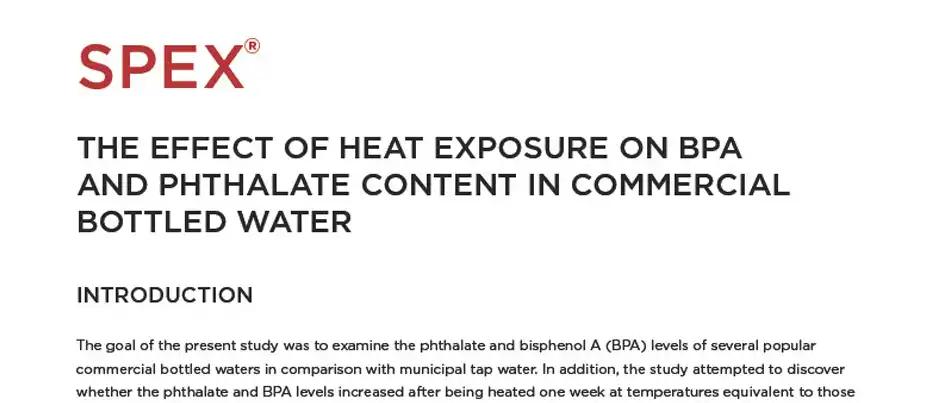
Effect of Heat Exposure on BPA and Phthalate Content in Commercial Bottled Water
The goal of the present study was to examine the phthalate and bisphenol A (BPA) levels of several popular commercial bottled waters in comparison with municipal tap water. In addition, the study attempted to discover whether the phthalate and BPA levels increased after being heated one week at temperatures equivalent to those reached inside an automobile during the summer (60 °C). Samples were extracted and tested for phthalate and BPA levels by GC/MS. The concentration of phthalates and BPA found in all the commercially bottled water samples and the municipal water sources were either non-existent or well below established guidelines. In addition, the exposure of bottled water to heat did not significantly increase the concentration of phthalates. BPA was not detected in any of the bottled water or municipal water source.
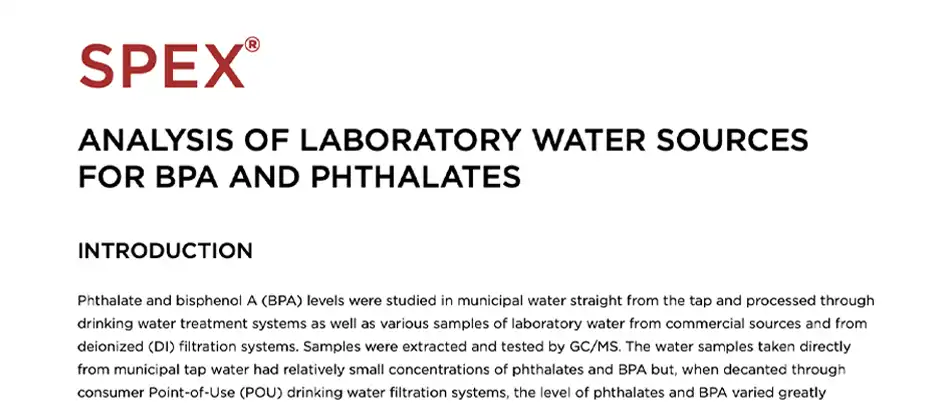
Analysis of Laboratory Water Sources for BPA and Phthalates
Phthalate and bisphenol A (BPA) levels were studied in municipal water straight from the tap and processed through drinking water treatment systems as well as various samples of laboratory water from commercial sources and from deionized (DI) filtration systems. Samples were extracted and tested by GC/MS. The water samples taken directly from municipal tap water had relatively small concentrations of phthalates and BPA but, when decanted through consumer Point-of-Use (POU) drinking water filtration systems, the level of phthalates and BPA varied greatly depending on the type of system and the amount of water flushed from the system prior to the sample being taken. Laboratory water sources appeared to have the greatest variability on phthalate concentration with LC-MS grade water having the lowest phthalate and BPA concentrations of all the laboratory water.
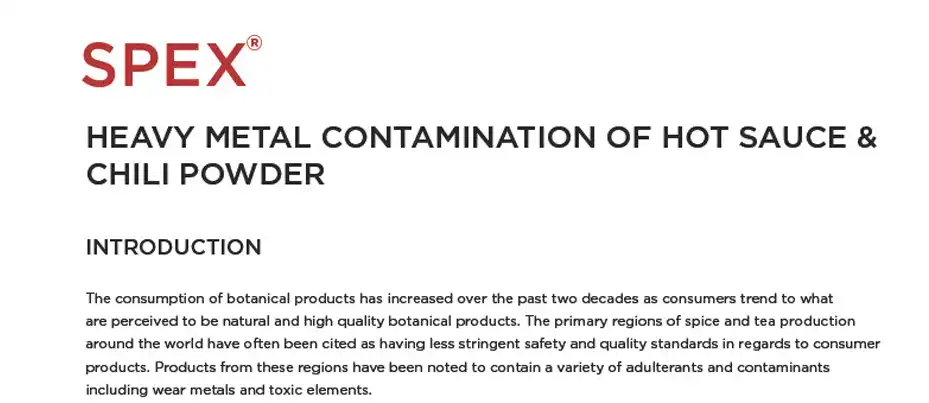
Heavy Metal Contamination of Hot Sauce and Chili Powder
The consumption of botanical products has increased over the past two decades as consumers trend to what are perceived to be natural and high quality botanical products. The primary regions of spice and tea production around the world have often been cited as having less stringent safety and quality standards in regards to consumer products. Products from these regions have been noted to contain a variety of adulterants and contaminants including wear metals and toxic elements.
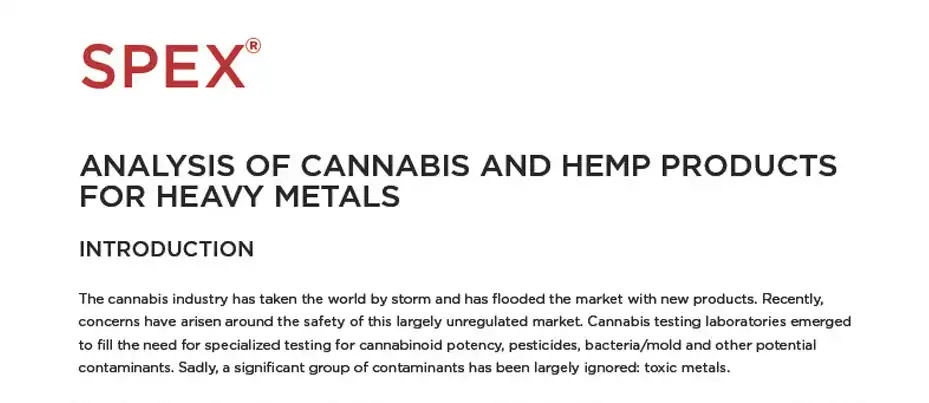
Analysis of Cannabis and Hemp Products for Heavy Metals
The cannabis industry has taken the world by storm and has flooded the market with new products. Recently, concerns have arisen around the safety of this largely unregulated market. Cannabis testing laboratories emerged to fill the need for specialized testing for cannabinoid potency, pesticides, bacteria/mold and other potential contaminants. Sadly, a significant group of contaminants has been largely ignored: toxic metals.
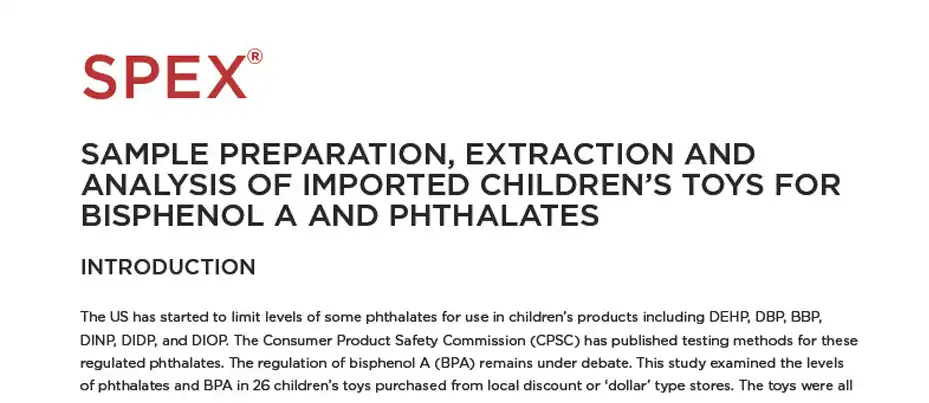
Sample Preparation Extraction Analysis Imported Childrens Toys
The US has started to limit levels of some phthalates for use in children’s products including DEHP, DBP, BBP, DINP, DIDP, and DIOP. The Consumer Product Safety Commission (CPSC) has published testing methods for these regulated phthalates. The regulation of bisphenol A (BPA) remains under debate. This study examined the levels of phthalates and BPA in 26 children’s toys purchased from local discount or ‘dollar’ type stores. The toys were all reported as being made in China.
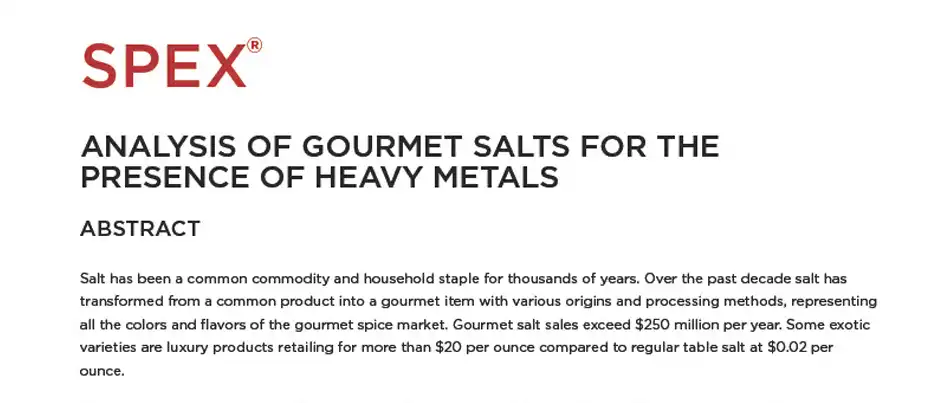
Analysis Gourmet Salts for Presence of Heavy Metals
Salt has been a common commodity and household staple for thousands of years. Over the past decade salt has transformed from a common product into a gourmet item with various origins and processing methods, representing all the colors and flavors of the gourmet spice market. Gourmet salt sales exceed $250 million per year. Some exotic varieties are luxury products retailing for more than $20 per ounce compared to regular table salt at $0.02 per ounce.
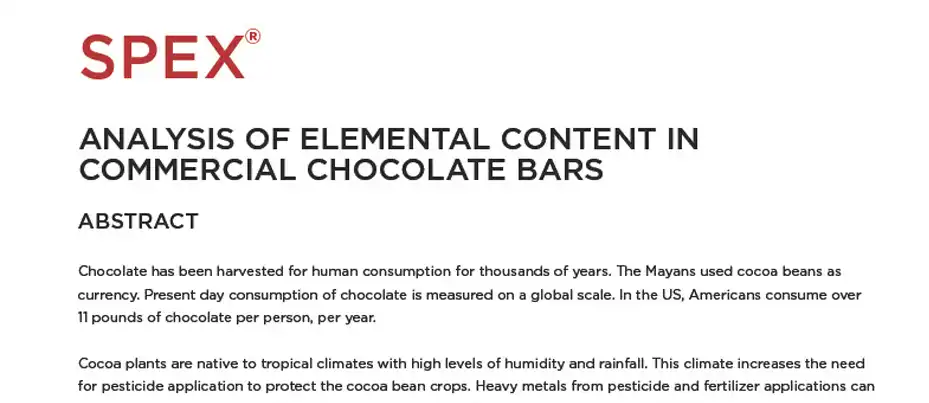
Analysis of Elemental Content Commercial Chocolate Bars
Chocolate has been harvested for human consumption for thousands of years. The Mayans used cocoa beans as currency. Present day consumption of chocolate is measured on a global scale. In the US, Americans consume over 11 pounds of chocolate per person, per year.
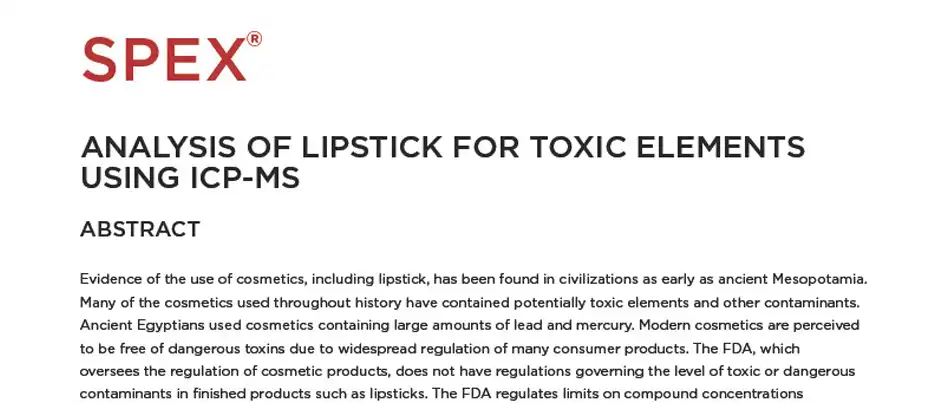
Analysis of Lipstick for Toxic Elements Using ICP-MS
Evidence of the use of cosmetics, including lipstick, has been found in civilizations as early as ancient Mesopotamia. Many of the cosmetics used throughout history have contained potentially toxic elements and other contaminants. Ancient Egyptians used cosmetics containing large amounts of lead and mercury. Modern cosmetics are perceived to be free of dangerous toxins due to widespread regulation of many consumer products. The FDA, which oversees the regulation of cosmetic products, does not have regulations governing the level of toxic or dangerous contaminants in finished products such as lipsticks. The FDA regulates limits on compound concentrations of additives and colorants but no overall regulation is in place for the finished product’s level of potential contamination.
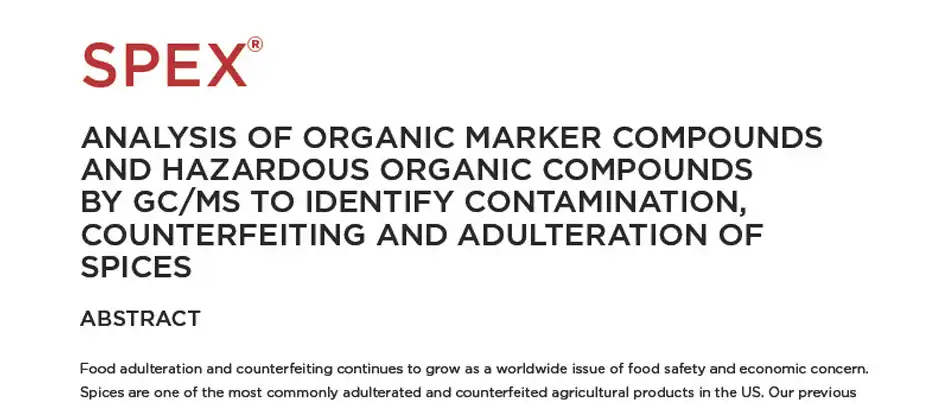
Analysis of Organic Marker Compounds
Food adulteration and counterfeiting continues to grow as a worldwide issue of food safety and economic concern. Spices are one of the most commonly adulterated and counterfeited agricultural products in the US. Our previous study determined extensive elemental and heavy metals contamination and adulteration in spices. Many of our spice products were identified as possibly being highly adulterated or contaminated by metals. In our follow-up Organic study, we focused on the organic markers and toxic organic compounds in our common spices and botanicals (black pepper and cinnamon) in various forms (i.e. spices, teas, condiments and supplements) to determine if these products appeared to be adulterated from an organic compound standpoint as well as an elemental standpoint.
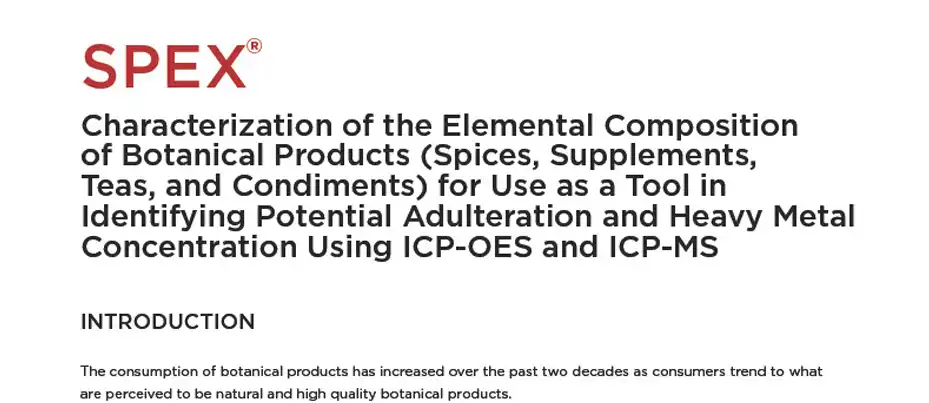
Characterization of Elemental Composition of Botanical Products
The consumption of botanical products has increased over the past two decades as consumers trend to what are perceived to be natural and high quality botanical products. The primary regions of spice and tea production around the world have often been cited as having less stringent safety and quality standards in regards to consumer products. Products from these regions have been noted to contain a variety of adulterants and contaminants including wear metals and toxic elements.
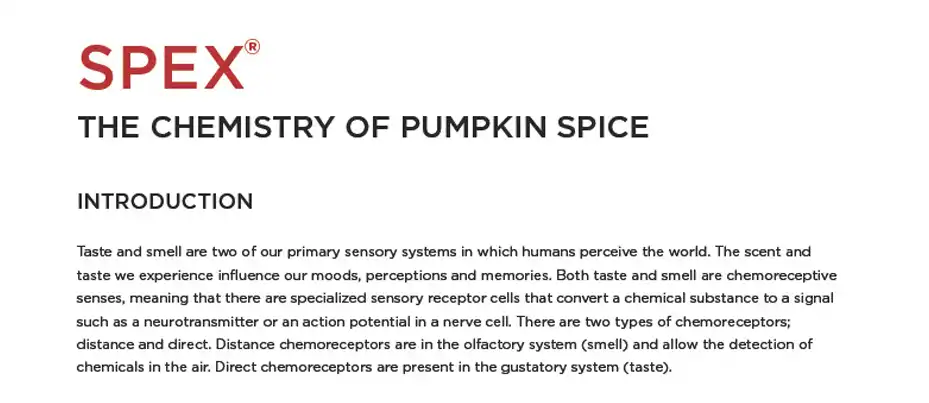
Chemistry of Pumpkin-Spice
Taste and smell are two of our primary sensory systems in which humans perceive the world. The scent and taste we experience influence our moods, perceptions and memories. Both taste and smell are chemoreceptive senses, meaning that there are specialized sensory receptor cells that convert a chemical substance to a signal such as a neurotransmitter or an action potential in a nerve cell. There are two types of chemoreceptors; distance and direct. Distance chemoreceptors are in the olfactory system (smell) and allow the detection of chemicals in the air. Direct chemoreceptors are present in the gustatory system (taste).
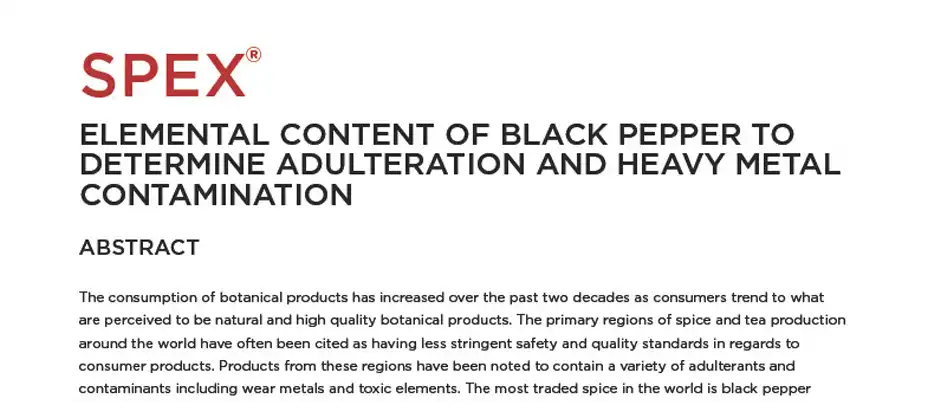
Elemental Content of Black Pepper Heavy Metal Contamination
The consumption of botanical products has increased over the past two decades as consumers trend to what are perceived to be natural and high quality botanical products. The primary regions of spice and tea production around the world have often been cited as having less stringent safety and quality standards in regards to consumer products. Products from these regions have been noted to contain a variety of adulterants and contaminants including wear metals and toxic elements. The most traded spice in the world is black pepper and accounts for 20% of the world spice market. It is also one of the most commonly adulterated spices on the marketplace with up to 70% of commercial black pepper samples showing some form of adulteration or counterfeiting.
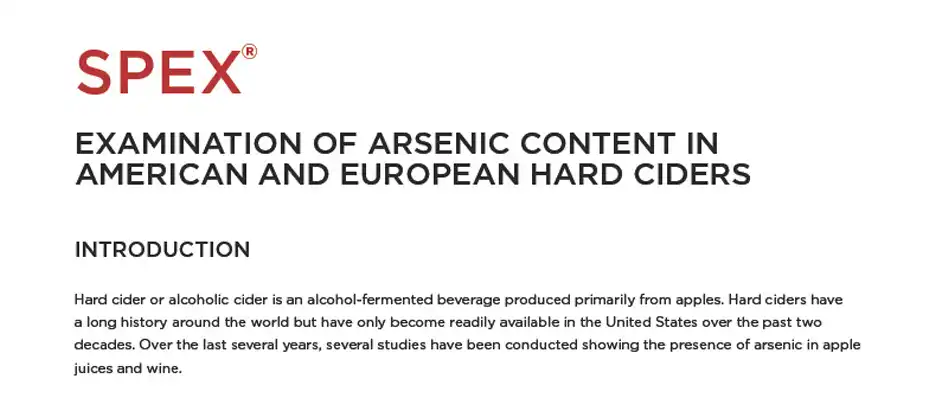
Examination of Arsenic Content in American and European Hard Ciders
Hard cider or alcoholic cider is an alcohol-fermented beverage produced primarily from apples. Hard ciders have a long history around the world but have only become readily available in the United States over the past two decades. Over the last several years, several studies have been conducted showing the presence of arsenic in apple juices and wine.
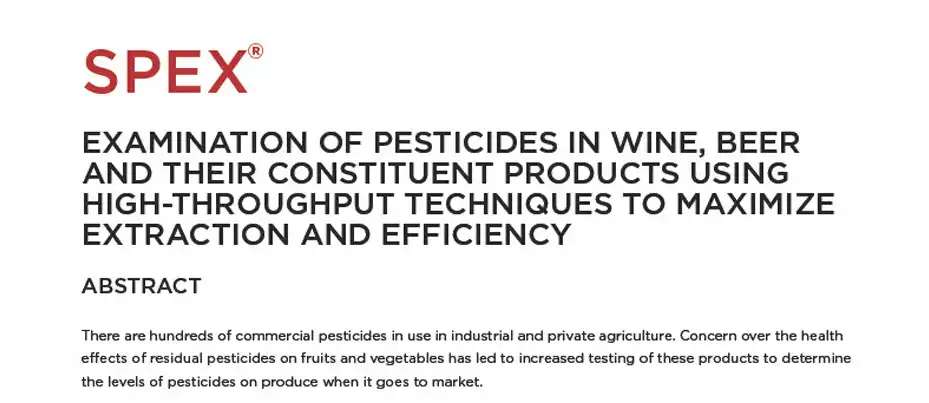
Examination of Pesticides in Wine and Beer
There are hundreds of commercial pesticides in use in industrial and private agriculture. Concern over the health effects of residual pesticides on fruits and vegetables has led to increased testing of these products to determine the levels of pesticides on produce when it goes to market. In this study, commercial red wine and beer samples were examined for their pesticide concentrations. In addition to the examination of the finished alcoholic beverage, the constituent agricultural products of wine and beer production (grains, malts, hops, and wine grapes) were also examined to determine the levels of pesticides found in those products. The sample preparation and extraction process efficiency and recovery were examined by processing samples using manual versus high-throughput techniques. The QuEChERS method was used to process a greater number of samples in a shorter period of time than other extraction methods.
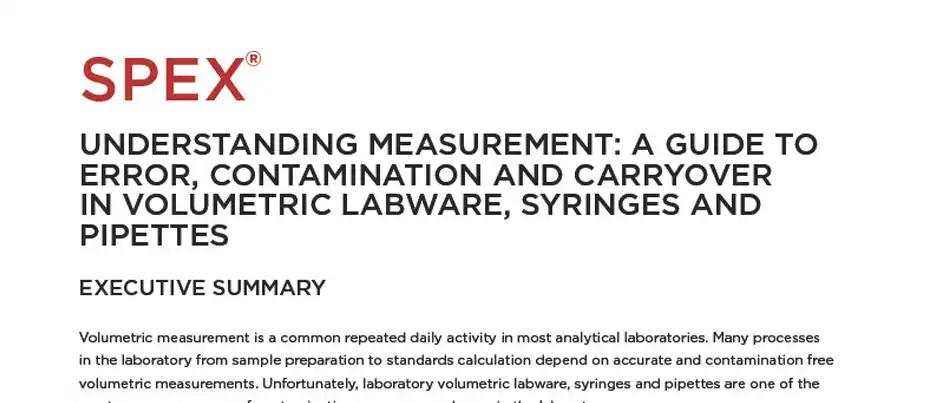
Understanding Measurement
Volumetric measurement is a common repeated daily activity in most analytical laboratories. Many processes in the laboratory from sample preparation to standards calculation depend on accurate and contamination free volumetric measurements. Unfortunately, laboratory volumetric labware, syringes and pipettes are one of the most common sources of contamination, carryover and error in the laboratory.
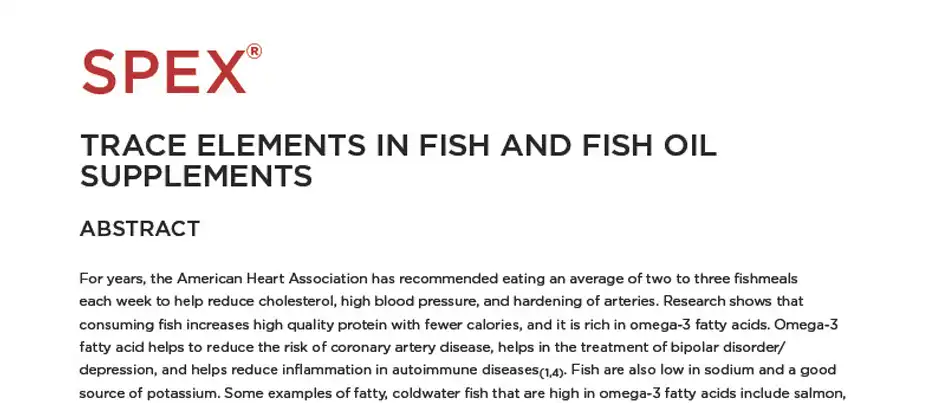
Trace Elements in Fish and Fish Oil Supplements
For years, the American Heart Association has recommended eating an average of two to three fishmeals each week to help reduce cholesterol, high blood pressure, and hardening of arteries. Research shows that consuming fish increases high quality protein with fewer calories, and it is rich in omega-3 fatty acids. Omega-3 fatty acid helps to reduce the risk of coronary artery disease, helps in the treatment of bipolar disorder/ depression, and helps reduce inflammation in autoimmune diseases₍1,4₎. Fish are also low in sodium and a good source of potassium. Some examples of fatty, coldwater fish that are high in omega-3 fatty acids include salmon, mackerel, and herring.